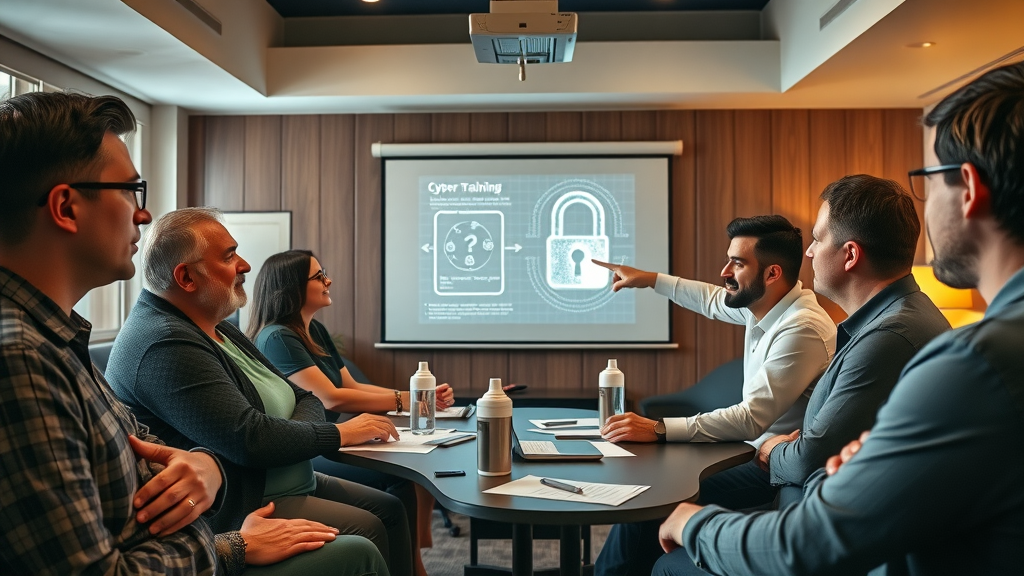Did you know that nearly 60% of nonprofit organizations have experienced a cyberattack in the past year? This unsettling statistic isn’t just a number—it represents the growing threat landscape surrounding mission-driven groups. Ignoring cybersecurity for nonprofit organizations can put sensitive data, organizational integrity, and trust at risk. In this guide, you’ll find the critical knowledge and actionable steps to protect your organization, its mission, and the people you serve from growing digital threats.
Cybersecurity for Nonprofit Organizations: Why It’s Critical
"According to recent studies, nearly 60% of nonprofit organizations have experienced a cyberattack in the past year, making cybersecurity for nonprofit organizations an urgent necessity."
Nonprofit organizations play a vital role in society, supporting vulnerable populations, advocating for important causes, and managing vast amounts of sensitive information—from personally identifiable information (PII) to personal health and financial data. As these organizations increasingly rely on digital tools to fulfill their missions, they also become attractive targets for cybercriminals searching for valuable data with often limited security measures in place.
Unlike large corporations, many nonprofit organizations operate on tight budgets and have constrained IT resources, leaving gaps in their cyber security defenses. Cyberattacks can compromise donor trust, lead to costly legal consequences following a security breach, and seriously disrupt services. Adopting robust digital security protocols is no longer optional—it is vital for safeguarding the organization, its stakeholders, and the cause itself.

What You’ll Learn in This Guide to Cybersecurity for Nonprofit Organizations
- Key cybersecurity risks for nonprofit organizations
- Common digital security challenges facing nonprofits
- Assessment tools for measuring security risk
- Steps to strengthen cyber security frameworks
- How to respond to data breaches
- Best practices for ongoing nonprofit cybersecurity
Understanding the Unique Security Risks Faced by Nonprofit Organizations
No two organizations face exactly the same cybersecurity challenges, but nonprofit organizations share several unique vulnerabilities. They often process sensitive data related to donors, clients, or beneficiaries, including personal health or identifiable information. When this information is compromised, the repercussions can be severe—damaged reputations, lost funding, regulatory penalties, and loss of mission effectiveness.
Additionally, many nonprofits rely on volunteers or undertrained staff, making security awareness a major concern. Limited budgets may also prevent investments in up-to-date technology or regular cybersecurity risk assessments. Furthermore, nonprofits commonly collaborate with third-party vendors or utilize free or low-cost software, which can introduce unmonitored entry points and increase cybersecurity risks. Recognizing these unique risk factors is the first step towards developing a robust defense strategy.
Common Cybersecurity Risks Targeting Nonprofit Organizations
- Data breaches and exposure
- Identity theft
- Insider threats
- Social engineering attacks
- Compromised strong password regimes
A data breach can occur when internal systems are compromised through stolen credentials or weak security practices, resulting in unauthorized access to personal and financial data. Identity theft can place clients and donors at direct risk, while insider threats—malicious or accidental actions by employees or volunteers—can expose sensitive information sometimes more easily than outside attacks.
Social engineering attacks such as phishing scams prey on organizational trust, tricking staff into divulging logins or sensitive files. Even the compromise of a strong password—especially one reused or not regularly updated—opens doors to larger security breaches and potential data breaches. Understanding these risks helps nonprofit organizations protect your organization by building strategic defenses tailored to their evolving threat landscape.

Key Digital Security Challenges for Nonprofit Organizations
One pressing challenge for nonprofit organizations is managing limited resources while defending against increasingly sophisticated cybersecurity risks. Digital transformation, while essential for modern operations, introduces vulnerabilities if not paired with adequate cyber security investments. This is especially problematic with limited budgets, lack of IT personnel, and reliance on outdated systems.
Another crucial issue is maintaining up-to-date security awareness among staff and volunteers. Cybercriminals often exploit human error—phishing, weak passwords, or social engineering—to infiltrate networks. Because nonprofit teams frequently operate with high turnover, ensuring constant digital security education and awareness is tough. Overcoming these digital security challenges requires adopting a layered approach to cybersecurity for nonprofit organizations, combining technology, training, and proactive process updates.
Cybersecurity Assessment Tools for Nonprofit Organizations
Top Assessment Tools to Evaluate Security Risk
| Assessment Tool | Purpose | Cost | Recommended For |
|---|---|---|---|
| Cyberpeace Institute Toolkit | Risk assessment tailored for nonprofit organizations | Free | Small organizations |
| NIST Cybersecurity Framework | Comprehensive security risk evaluation | Free | All nonprofits |
| Third-Party Cybersecurity Service Provider Tools | Automated assessments and monitoring | Varies | Medium and large nonprofits |
Implementing a reliable assessment tool like the free solutions from Cyberpeace Institute or the universally recognized NIST Cybersecurity Framework allows organizations to identify vulnerabilities, prioritize solutions, and track progress. Automated tools from cybersecurity service providers offer continuous monitoring and threat detection, an ideal pairing for nonprofits with more complex infrastructure or sensitive operational needs.
By regularly evaluating security risks, nonprofit organizations can proactively address gaps before they result in a damaging data breach or security breach. Even those with limited resources can deploy free or affordable tools to maintain compliance with digital security standards and protect your organization against rising threats.

Best Practices for Cybersecurity for Nonprofit Organizations
Building a Strong Password Policy
- Use password managers
- Mandate regular password changes
- Educate staff about phishing and social engineering
Creating a strong password policy is fundamental for nonprofit organizations. Using a reputable password manager, enforcing regular password changes, and avoiding reused credentials hugely reduce the attack surface for data breaches. Education is just as crucial—staff should recognize the red flags of phishing scams and social engineering attempts that could compromise network access.
Regular audits and system prompts for password updates further protect against the compromise of stored or shared credentials. These efforts—combined with two-factor authentication and enforcing strict access controls—help ensure only authorized individuals can reach sensitive data, greatly reducing the risk of a disastrous security breach.
Employee Training to Reduce Security Risks
"Staff awareness is the frontline defense for nonprofit organizations against cybersecurity risks."
Continuous digital security training is a must-have for all nonprofit organizations seeking to minimize cybersecurity risks. With so many attacks originating through human error, empowering teams with regular workshops, simulated phishing campaigns, and hands-on exercises can transform your workforce into an active line of defense.
Training should not be a one-time event. Instead, offer ongoing education covering evolving threats like ransomware, phishing, and social engineering, tailored for both in-office and remote employees. Training also reassures donors and stakeholders that protecting personally identifiable information is a top priority, boosting overall organizational credibility and resilience.

Partnering with a Cybersecurity Service Provider
Working with a specialized cybersecurity service provider can make a significant difference in risk mitigation, especially for nonprofit organizations lacking in-house expertise. These providers offer services like real-time network monitoring, vulnerability assessments, threat remediation, and compliance assistance. Finding a provider familiar with the unique needs of nonprofits—exposure to personally identifiable information, limited budgets, and donor transparency—is key to maximizing value.
When selecting a service provider, evaluate their industry experience, references from other nonprofits, pricing flexibility, and scope of services. The right partner helps protect your organization by anticipating, preventing, and swiftly responding to cyber incidents and data breaches without draining critical funds from mission activities.
Responding to a Data Breach: Steps for Nonprofit Organizations
- Immediate actions following a data breach
- Notifying affected individuals
- Working with authorities
- Restoring data integrity
Swift, decisive action is essential when a data breach occurs at a nonprofit organization. The first steps should be to isolate affected systems, halt unauthorized access, and begin forensic investigation to determine the scope of the security breach.
Once the incident is contained, regulatory standards often require prompt notification of affected individuals, undertaking transparency and timely communication to help rebuild trust. Collaborate with authorities and legal advisors to comply with breach laws, then focus on repairing and securing compromised systems to restore data integrity. Establishing a cyber incident response plan ahead of time ensures everyone knows their responsibilities, minimizing operational and reputational fallout.

Case Studies: Cybersecurity for Nonprofit Organizations in Action
"Our nonprofit organization was able to recover swiftly from a ransomware attack by employing a robust cyber security plan focused on continuous risk assessment.” — Cyberpeace Institute report
Real-world experiences illustrate the importance of robust cybersecurity practices for nonprofit organizations. For example, a global humanitarian nonprofit suffered a ransomware attack, causing network outages and putting sensitive information at risk. Thanks to a proactive approach—regular risk assessments, staff training, and an incident response plan—this organization contained the attack, reported transparently to donors, and restored operations within days.
Other organizations that failed to implement strong policies were less fortunate, facing lengthy downtimes and loss of donor trust. These case studies prove that cybersecurity risks are not a remote possibility but a daily concern, and a strong cyber security plan is the best insurance against disaster.
Cybersecurity Resources and Support for Nonprofit Organizations
- Cyberpeace Institute guidance
- Government-sponsored cybersecurity service providers
- Nonprofit sector security frameworks
- Online training and education materials
Many quality resources are available to help nonprofit organizations enhance their cybersecurity infrastructure. The Cyberpeace Institute offers toolkits, webinars, and guides tailored to nonprofits. Government-sponsored programs provide free cybersecurity assessments and consulting, often focusing on mission-driven organizations.
Don’t overlook nonprofit sector frameworks, such as NIST, which provide templates for risk assessments, policies, and compliance. Online platforms and professional organizations deliver continuously updated training materials, ensuring your staff can spot and prevent cybersecurity risks before they escalate. Leverage these resources to strengthen your digital security posture without overextending your operational budget.

Videos: Cybersecurity for Nonprofit Organizations Essentials
People Also Ask: Cybersecurity for Nonprofit Organizations
What are the biggest cybersecurity risks for nonprofit organizations?
The most significant cybersecurity risks include data breaches, identity theft, social engineering attacks (like phishing), insider threats from employees or volunteers, and vulnerabilities due to weak or compromised strong password practices. These can all lead to unauthorized access to personally identifiable information, loss of donor trust, financial losses, and reputational harm. Proactive training, strong policies, and regular use of assessment tools are critical for defense.
How can nonprofit organizations start improving their cybersecurity?
Nonprofit organizations can begin by assessing their current digital security posture using free or low-cost tools such as the Cyberpeace Institute toolkit. Enforcing a strong password policy, offering staff education in security awareness, and keeping systems updated are essential starting points. Regularly reviewing and updating protocols, and seeking out reputable cybersecurity service providers for guidance, will help to continually strengthen cyber defenses and protect valuable data.
What is the role of a cybersecurity service provider for nonprofits?
A cybersecurity service provider works alongside nonprofit organizations to monitor network activities, identify threats, and respond swiftly to cyber incidents. They can deliver vulnerability assessments, onboard staff to best practices, assist with compliance, and ensure effective backup and recovery procedures are in place. Trusted providers allow nonprofits to focus on their missions without compromising on data security.
Frequently Asked Questions: Cybersecurity for Nonprofit Organizations
-
Why is cybersecurity important for nonprofit organizations?
It protects sensitive data (like donor and client information), keeps your mission safe, and protects your reputation from data breaches and cyber incidents. -
How can we measure our security risk?
Use free or affordable assessment tools such as those from the Cyberpeace Institute or NIST to identify current gaps and prioritize improvements. -
What should we do after a data breach?
Isolate the breach, inform authorities, notify those affected, and take steps to improve future digital security by reviewing what went wrong. -
Where to find affordable cyber security solutions?
Leverage free cybersecurity resources from the government, not-for-profit guidance groups, and explore budget-friendly solutions offered by reputable cybersecurity service providers. -
Should we use two-factor authentication everywhere?
Yes. Enable two-factor authentication on all accounts where possible—this extra layer protects personal information even if a password is stolen or leaked.
Key Takeaways: Protecting Nonprofit Organizations with Robust Cybersecurity
- Nonprofits are increasingly targeted by cybercriminals.
- Assess security risks regularly.
- Institute reliable digital security education.
- Utilize assessment tools and strong password standards.
- Partner with reputable cybersecurity service providers.
Conclusion: Take Action Today to Secure Your Nonprofit Organization
Building strong cybersecurity for nonprofit organizations isn't just good practice—it's essential for protecting your mission and those you serve. Secure your future: act now, train your team, update your systems, and partner smartly. Call me the Chaplain 786-333-5270.
To further enhance your understanding of cybersecurity for nonprofit organizations, consider exploring the following resources:
- “A Best Practice Guide to Cybersecurity for Nonprofits” (nlctb.org)
This guide outlines seven essential practices, including regular employee training, strong password policies, and data encryption, tailored specifically for nonprofits.
- “7 Essential Cybersecurity Practices Every Nonprofit Needs” (keystonecorp.com)
This article delves into critical areas such as conducting regular cybersecurity assessments, implementing multi-factor authentication, and prioritizing user security training to safeguard nonprofit operations.
By integrating these best practices, your organization can significantly strengthen its defenses against cyber threats, ensuring the protection of sensitive data and maintaining the trust of your stakeholders.
 Add Row
Add Row  Add
Add 




Write A Comment